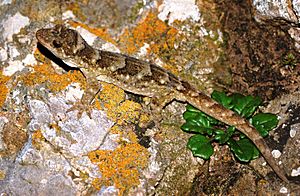Hoplodactylus facts for kids
Quick facts for kids Hoplodactylus |
|
|---|---|
 |
|
| Duvaucel's gecko (Hoplodactylus duvaucelii) | |
| Scientific classification |
|
| Kingdom: | Animalia |
| Phylum: | Chordata |
| Class: | Reptilia |
| Order: | Squamata |
| Family: | Diplodactylidae |
| Genus: | Hoplodactylus Fitzinger, 1843 |
| Species | |
|
See text |
|
Hoplodactylus is a group of geckos that live only in New Zealand. These geckos are special because they are one of seven types of geckos found nowhere else in the world! The Hoplodactylus group includes two kinds of geckos: one is very large and brownish, but it's now extinct. The other kind still lives today, but only on islands where there are no predators like rats.
Contents
What do Hoplodactylus Geckos Look Like?
Most Hoplodactylus geckos are usually brown or grey. They don't have many bright colors. However, some, like the forest gecko, can be mottled green. One special gecko, the "Harlequin Gecko," has a cool pattern of green, brown, black, and white.
Amazing Camouflage and Temperature Control
Even though they aren't super colorful, Hoplodactylus geckos are amazing at changing their skin color. This helps them blend in with their surroundings, making it harder for predators to spot them. It's like having a built-in camouflage system!
Changing color also helps them control their body temperature. When it's cold, they can make their skin darker to soak up more heat from the sun. When it's hot, they can lighten their skin to reflect sunlight and stay cool.
Night Owls and Ground Explorers
Most Hoplodactylus geckos are nocturnal, meaning they are active at night. This is different from another group of New Zealand geckos called Naultinus, which are active during the day. Hoplodactylus geckos also spend time on the ground, looking for food. They don't just stay in trees.
Tails and Toes
Hoplodactylus geckos do not have prehensile tails. This means their tails can't grip things like branches. Because of this, they are more likely to drop their tails if a predator grabs them. This helps them escape danger.
Many Hoplodactylus geckos also have wider, more expanded toes. These wider toe pads help them climb smooth surfaces better.
Types of Hoplodactylus Geckos
There are two main species in the Hoplodactylus group.
Duvaucel's Gecko
Hoplodactylus duvaucelii is the biggest gecko still living in New Zealand. Sadly, because of mammals like brown rats that were brought to New Zealand, these geckos now only live on islands where there are no such predators.
Delcourt's Giant Gecko (Extinct)
The kawekaweau, also known as Delcourt's giant gecko (Hoplodactylus delcourti), was the largest gecko ever known in the world! It was first described in 1986. The only known specimen was found in the early 1800s but was forgotten in a French museum for over a hundred years. This amazing gecko is now extinct.
Species list
- †kawekaweau/Delcourt's giant gecko, Hoplodactylus delcourti (extinct)
- Duvaucel's gecko, Hoplodactylus duvaucelii
See also
 In Spanish: Hoplodactylus para niños
In Spanish: Hoplodactylus para niños

